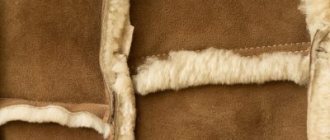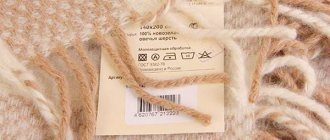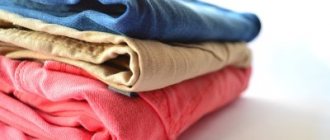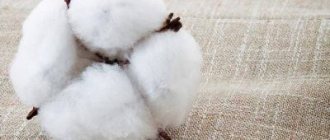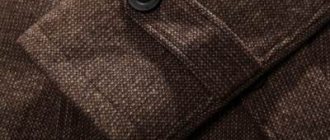Light openwork, soft cashmere, warm wool sweaters are an integral element of any women's and men's wardrobe.
Caring attitude and proper care will help preserve the original appearance of your favorite item for a long time.
We will tell you in this article how to wash a jacket correctly in order to avoid the unpleasant moments of losing the shape and color of the product.
Nuances depending on the color of the product
White sweaters are washed only by hand, using a special whitening shampoo.
Algorithm of actions:
- Warm water (no more than 30°C) is filled into a basin and liquid detergent with a bleaching effect is added (the dosage is indicated by the manufacturer on the packaging).
- The item is immersed in water, gently wrung out and crumpled.
- After washing, rinse the product thoroughly in cold water.
Rinsing in water with the addition of freshly squeezed lemon juice will help keep your favorite item white.
Colored and black sweaters are washed separately (including from white items). The first wash of a new colored or black item must be done by hand .
This will help make sure whether the product is shedding or not. The jacket can be washed again either in a washing machine or by hand (manufacturer's recommendations are indicated on the tag).
Basic rules for washing black and colored items:
- water temperature not higher than 30°C;
- choosing laundry detergents only in favor of liquid formulations for colored and black items (they do not wash out the colored pigment from the fabric);
- minimum spin speed;
- wash on the “delicate fabric” or “wool” mode;
- dry only in a dark, well-ventilated place.
In the washing machine
If you find instructions on the clothing label that allow machine washing, remove all decorative elements before loading them into the drum. It is also worth sewing up anything that is torn and turning the product inside out. Then the following procedure is assumed:
- Place the sweater in the drum. A special bag will protect the product from damage.
- Add detergent to the powder receptacle.
- Turn on the “Wool” program or another delicate wash program.
- Set a suitable temperature (no higher than 30 °C).
- Select "400 rpm" for spin.
- Start the workflow.
After finishing washing, remove the sweater from the drum, then wring it properly and dry it well.
Washing in SMA
What to do if the item is colored after washing?
There are several ways to fix the problem of items faded after washing.
If the jacket is made of natural threads, ammonia will help restore it to its original appearance. It is enough to dilute it in water (ratio 1:20) and soak faded clothes in the resulting solution for forty minutes. Afterwards the item is rinsed in cool water.
Synthetic sweaters will be cleaned with laundry soap. Dip the soiled item into a soap solution (three or four tablespoons of grated laundry soap are dissolved in water), wait thirty minutes, and then wash the item as usual.
Preparing for washing
Usually there are tags on things that indicate the composition of the yarn used, washing rules, and the possibility of soaking and drying. But sometimes it happens that such valuable information is lost during operation, and then you have to figure it out yourself. This is a very important stage in preparation for washing, because the correct choice of temperature, drying and care depends on the composition of the yarn. If these factors are not observed, the product may be hopelessly damaged.
Material Definition
Craftsmen who often deal with yarn have learned to distinguish between natural and synthetic fibers visually, by touch and by action. Let's look at each method.
Visually
- To recognize synthetics, you need to vigorously rub them against your hair in bright daylight or artificial light. If you hear a characteristic crackling sound and notice sparks, then this is a synthetic fiber.
- When exposed to light, natural raw materials exhibit threads of unequal thickness. Whereas artificial fibers are almost perfect.
- Synthetic fabric often forms pellets, while wool is almost devoid of them.
To the touch
- Try covering the item with your palm. After 5 minutes, heat will come from the natural fiber. If the sensations have not changed, then you have synthetics.
- When rubbed with your fingers, acrylic makes a creaking sound, while natural material is silent.
- Synthetic is an extremely heavy fabric by weight, while wool, even with its impressive volume, is practically not felt by the body.
- Fake material does not heat up when worn, but natural material gives a feeling of soft warmth.
Actions
- The most common test is fire. To do this, you need to find a small piece of thread and light it with a match or lighter. If you smell a synthetic plastic smell or notice traces of melting, then this is an obvious fake and the yarn is not natural.
- When real wool fiber burns, it smells like burnt wool and leaves a black ball at the end that can be easily crushed with your fingers.
- Cotton, linen and viscose quickly ignite in a bright fire, smell like burnt paper and leave behind traces of ash.
- If you press hard on the product with your hand, a faint matte print will remain on the natural fabric, while a shiny mark will be visible on the synthetic fabric.
- When moistened, a specific smell of wet wool is felt, which is also one of the methods for determining the natural origin of the yarn.
Tip: if the knitted fabric has lost its elasticity, fill the bathroom with steam, hang the clothes on hangers for several hours, and then dry them outside.
Checking the quality of coloring
Before you wash a knitted item, you should definitely conduct a paint fastness test. This will protect multi-colored canvases from cross-staining, and plain ones from losing color.
You need to moisten an inconspicuous area of the product with plain water. It must be wrapped in a white cloth and carefully ironed over it with a hot iron. If after the manipulation you have not noticed any color prints on the light fabric, it means that the knitted item is dyed with high quality. If you find colored stains, pay attention to the temperature of the water in which you are going to wash the item: it should be slightly lower than indicated on the label.
Soak
Knitted garments react very negatively to prolonged soaking. This process can last a maximum of 10 minutes. With longer immersion in water, deformation is often observed: shrinkage, stretching, uneven stretching of individual areas. Therefore, be sure to remember this requirement in order to avoid mistakes and not lose your favorite blouse, jumper or some other wardrobe item.
What to do if you are stretched?
Mistakes made when washing a sweater can cause deformation of the product. There are several ways to restore the original appearance and shape of a stretched item.
Making a machine knitted blouse smaller
This method involves using a washing machine:
The stretched jacket is placed in a special washing bag and loaded into the drum.- Liquid detergent for wool is poured into the special compartment of the washing machine, the water temperature is set to 30°C, and the “wool” washing mode is set. The drying and spinning option is disabled.
- The wash starts, after which the product is carefully laid out on a horizontal surface to dry. The required shape is given to the knitted product by hand.
Hand tied
In this case, the knitted product can only be reduced manually.
Algorithm of actions:
- a bath is filled with warm water, into which the jacket is immersed;
- after the knitted product is completely saturated with moisture, it is taken out and, without wrung out, carefully wrapped in a towel;
- the final stage - the still damp item is laid out on a dry terry towel, the item is given the desired shape and left to dry completely.
Locally stretched places
In this case, the product is not completely wetted, but only those places that have stretched.
The partially wetted product is laid out on a horizontal surface. You can speed up the drying process by using cold air from a hair dryer.
General rules for washing sweaters, jumpers, jackets
komissionka_by_jana
made_in_russia.jjj
maria.leonova_knit
Acrylic
An acrylic jacket tolerates machine washing well, since this material is artificial. If there is a need to refresh an acrylic product, you should adhere to the following recommendations:
- Choose a temperature that does not exceed 30 °C.
- Turn the item inside out.
- A special mesh bag will protect the fabric from damage when rubbing against the surface of the drum.
- Repeat the rinse cycle.
- Wring out the sweater by hand or set the spin speed to no more than 400 rpm.
Expert opinion
Irina. Housewife.
Ask a Question
If you add an antistatic conditioner during rinsing, the item will become less electrified during wear. For light acrylic, you can add a small amount of bleach.
From angora
Unlike acrylic, angora is recommended to be washed exclusively by hand, in warm water, the temperature of which does not exceed 30 °C. To do this you need:
- fill the container with water;
- dilute detergent in it;
- immerse the product in the resulting solution;
- After 10 minutes, start delicate washing;
- Rinse the sweater until all foam is removed.
Wash the item carefully using gentle pressing movements, avoiding twisting. It is better to wring out an angora sweater in this way: wrap the product in a towel and press lightly so that it absorbs moisture.
Then lay the clothes out on a horizontal surface. Place a dry towel or diaper.
It is better to wash natural material with special detergents, which can be found in the household department. Adding glycerin when rinsing will make the angora softer and fluffier.
Woolen
You can wash wool clothes in a machine. To do this, you must select a special mode, if provided in the device. In another situation, it is better to refresh the sweater manually.
Recommendations for the washing process will be the same as in the case of angora:
- Do not use too hot water.
- Wash and wring extremely delicately.
- Dry the sweater in a horizontal position.
Expert opinion
Irina. Housewife.
Ask a Question
Remember that woolen clothes will become deformed if you do not follow the rules for caring for the natural material.
How to stretch if you sit down?
There are several ways to stretch a jacket that has shrunk after washing:
Repeated washing . The item reduced in size is washed again, without using detergents. After washing, the knitted item is hung on hangers to dry. Under the weight of its own weight, the jacket increases in size.- Steaming. The damp jacket is laid out on an ironing board, and carefully stretching the item in the desired direction, it is smoothed with an iron with the steaming function connected. The steaming method is good for products of mixed composition. This method is not suitable for woolen sweaters (under the influence of steam, the product may shrink).
- Rinse in vinegar water . The knitted product is immersed in a vinegar solution for thirty minutes (take one part vinegar to two parts water). Afterwards, the item is laid out on a table covered with a terry towel, and the desired shape of the knitted product is fixed with pins.
Read more about returning a shrunken sweater to its previous size here.
What tools to use
When choosing a detergent to wash your sweater, pay attention to the following:
- Liquid preparations are better rinsed out of things and do not clog the fabric structure.
- The composition should not contain alkali or bleaches.
- Using rinse aid will make the sweater softer.
- Non-aggressive products are suitable for removing stains. First check their effect in a hidden area.
- Start hand washing only after the detergent has completely dissolved in the water.
Do you store laundry in the washing machine?
Oh yes! No.
If you do not have the opportunity to purchase a special gel for washing woolen products, use hair shampoo or liquid soap. To soften the water, add vinegar, ammonia or glycerin.
Drying
The main rule of drying is that the jacket is never hung on a rope or hanger, but rather laid out on a horizontal surface to dry.
It is strictly forbidden to use automatic dryers for drying. Ignoring this rule will lead to complete deformation of the knitted product.
There are several ways to dry a washed blouse:
- Terry towel . It's simple: lay the jacket on a towel, and then roll it all up into a rope. During the drying process, the towel soaked in moisture is replaced with a dry one.
- Hair dryer. By directing a stream of cold air onto a laid out damp jacket, you can speed up the drying process several times.
- Microwave. This non-standard method is suitable for drying jackets without metal fittings. It is enough to place the product in the microwave and start the process for two to three minutes.
How to hand wash a woolen jacket?
Particularly delicate knitted and crocheted items are best washed by hand. To do this, you will need a bowl of warm water, gel or powder for hand washing and a little care.
- First, soak the product with a small amount of detergent. If the jacket is heavily soiled or has stains that are difficult to remove, you can add a little stain remover. Unless, of course, it is prohibited on the label.
Under no circumstances should you twist the item while spinning; you just need to squeeze it a little to get rid of excess liquid.
- After soaking, the woolen jacket should be washed carefully, without much effort, and then rinsed thoroughly, changing the water several times.
Adviсe
When washing sweaters, it is important to follow a few tips:
Rinsing in cool water with the addition of fabric softener will help reduce the ability of synthetic sweaters to accumulate static electricity.- Rinsing in water with added glycerin will help restore softness and fluffiness to the angora product.
- It is prohibited to use dry abrasive powders to wash jackets. Ignoring this recommendation may result in very small tears in the knitted fabric.
- It is strictly forbidden to dry a jacket on a radiator, near an open fire.
If you are interested in how to wash and clean outerwear, take a look here.
How to wash a wool sweater in a machine?
When machine washing woolen items, you need to choose a delicate cycle, or a special cycle for wool. If there is a “Rinse Plus” function, then it is better to use it. It's also a good idea to add conditioner to soften the coat.
Don't forget that any item washed with conditioner becomes flammable. Therefore, try not to go close to open flames while wearing a wool sweater.
You should not wash woolen items with others, especially if it is velvet or synthetics. Wool fibers, falling into water, settle on the surface of other fabrics. This causes pellets to form.
Summary
From now on, you will learn everything not only about how to wash knitted items, but also how to dry a sweater correctly and how to care for such things. I will be glad to see all your questions and additions in the comments.
For those who are interested in how to properly wash mohair, I have step-by-step instructions that you can familiarize yourself with by watching the video in this article.
This is unfair - cheap clothes made of questionable material often withstand almost anything. No need to worry about stretching or shrinking during washing. But sweaters made from natural fabrics can be pulled out of the car and... not be able to be worn. They require different care. You need to know how to wash a sweater, return an item that has shrunk to its original size after washing, or reduce the size of a stretched item.
How to store
You can use various methods to store knitwear. The appropriate one is chosen based on the type and properties of a particular item of clothing.
Thus, products made from thick threads (sweaters) can be folded into a stack and stored in a closet or plastic container. In this case, you need to make sure that things made of denser threads lie at the bottom, and light ones - on top. There is no point in filling a shelf or container completely; it is advisable that air can circulate freely there.
It is convenient to store T-shirts and other fine knitwear items, rolled up, in a dresser drawer. It is not recommended to hang knitted items on hangers. However, if necessary, you can do this so that the products do not stretch. This method is only suitable for sweaters; dresses cannot be stored this way, as they may stretch out:
- the sweater is folded lengthwise so that the sleeves are together;
- placed on a hanger so that there are sleeves on one side and the bottom of the product on the other (see photo).
To store knitted dresses, use only soft hangers, and the hem must be pinned to the area in the armpits - this technique helps to avoid pulling the fabric down.
Despite the fact that when washing knitwear you need to adhere to certain rules, caring for it is not too difficult, and items washed in accordance with the listed recommendations retain their original appearance.
This may be useful: How to wash woolen items.
Reasons for shrinkage of woolen items
Basically, things made from natural materials shrink due to an incorrectly set program and temperature when washing in a machine. As a result of these actions, the fabric fibers change their structure. The process is additionally affected by the spin mode.
Important! The greatest shrinkage occurs in products made from knitwear, natural cotton, angora, mohair, as well as acrylic and chenille knitted items. Particular attention should be paid to washing wool sweaters.
If a sweater shrinks after washing, you need to know how to restore its size and shape.
What not to do when washing
One of the most common mistakes people make when washing woolen clothes for the first time is using the normal cycle and temperatures above 40 °C. As a result, the thing shrinks and loses its shape. After such treatment, some correct the appearance of the new jumper, while others, unfortunately, cannot return it to its shape. Therefore, only use the program and temperature indicated on the label.
Hand washing is also not without risk. For example, strong twisting damages the structure of the threads and distorts the shape. It is better to wring out clothes with a terry towel, as indicated above.
| Tip 2 |
| Tip 3 |
| Tip 4 |
| Tip 5 |
Preparatory process
In order to preserve the appearance of cotton products for a long time, before washing it is worth carrying out some preparation, which consists of the following steps:
- Cotton wardrobe items are divided by color. White and undyed items are washed separately from colored items. This way, light and white things will retain their color, and colored ones will not fade, the colors will not fade.
- They are also divided by type of fabric; thin, lace cotton should not be cleaned with thicker types of fabric.
Attention! Synthetics with natural fibers should not be washed.
The detergent used will also be important. Any product that does not contain chlorine is suitable for cleaning.
To remove stains, mild stain removers, without solvents, are used. You can use folk remedies made from improvised materials.

